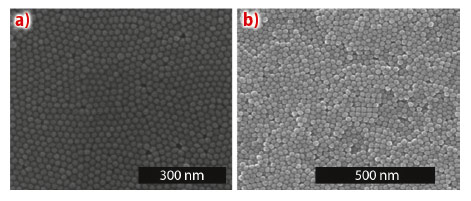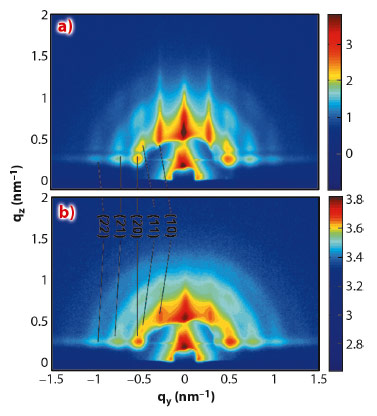- Home
- Users & Science
- Scientific Documentation
- ESRF Highlights
- ESRF Highlights 2012
- Soft condensed matter
- Structural correlations in iron oxide nanoparticle monolayers and multilayers
Structural correlations in iron oxide nanoparticle monolayers and multilayers
Chemically synthesised magnetic nanoparticles (NPs) can be self-assembled as a 2-dimensional (2-D) or three-dimensional (3-D) monolayer or multilayer, respectively. Their magnetic and electrical properties can be tuned depending on intra-particle structure and inter-particle ordering within the film. Therefore, it is important to understand their ordering in self-assembled monolayers and multilayers. The present report highlights the inter-particle ordering investigated by grazing-incidence small-angle X-ray scattering (GISAXS) at beamline ID10B.
Self-assembly is a process in which smaller building blocks, such as NPs, are spontaneously organised to form an ordered pattern [1]. These self-assembled monolayers and multilayers may show collective physical properties that are completely different from their constituting individual building blocks. The ordering of the NPs plays an important role in defining these properties. Therefore, a considerable effort is devoted to the understanding of their structure (chemical and magnetic) using synchrotron and neutron radiation.
Iron oxide NPs of mean diameter 20 nm (±1.4 nm) were spin-coated on a silicon substrate. The NPs are dispersed in a toluene solvent and remain separated due to oleic acid surfactants. They form monolayers and multilayers depending on the concentration of toluene. Figure 84a and Figure 84b show scanning electron microscope images of a monolayer and a multilayer, respectively. The NP films show a relatively long-range hexagonal close-packed order, interrupted by vacancies and disclinations.
 |
|
Fig. 84: SEM image of (a) monolayer and (b) multilayer iron oxide NP film. The hexagonal ordering can be recognised from the images. Originating from the principal publication. |
In NP films one encounters two different periodicities at the mesoscopic scale. One is the out-of-plane periodicity, which can be probed by specular reflectivity scans. The second one is the in-plane hexagonal order, which can be probed by GISAXS measurements and reveals the in-plane electron density variation. The GISAXS patterns were measured with a photon energy of 7.96 keV (λ = 0.127 nm). A MAR CCD camera captured the diffuse scattering at an incident angle of 0.15°. Figure 85a and Figure 85b show the GISAXS patterns from a monolayer and a multilayer, respectively. The patterns can be understood by the convolution of two factors. The first one is a ring-like intensity distribution, which represents the form factor of the NP shape and corresponds to the Fourier transform of the radial electron density of a spherical particle. On top of these rings, high intensity Bragg peaks are visible that originate from the 2-D long range hexagonal ordering, corresponding to the Fourier transform of the in-plane pair-correlation function.
 |
|
Fig. 85: GISAXS pattern measured for (a) monolayer and (b) multilayer. The colour codes show the intensity distributions, which are different for two images. Originating from the principal publication. |
The GISAXS patterns are indexed to a 2-D hexagonal lattice of 26.31 nm. The mismatch between the value of the lattice parameter and the mean diameter arises from the oleic acid shell surrounding the NPs. The Bragg peak widths were calculated from a Lorentzian fit yielding a mean value for the in-plane correlation length, which is 133 nm and 55 nm for the monolayer and the multilayer, respectively. The ordering in the normal direction was also investigated with X-ray reflectivity measurements and the multilayer shows a Bragg peak, which indicates that a well ordered NP multilayer can be prepared by the simple spin-coating method.
The in- and out-of-plane structural ordering has been correlated to the magnetic ordering. In fact polarised neutron reflectivity (PNR) reveals an enhanced magnetic correlation due to strong dipolar interaction amongst the superparamagnetic NPs. However, the contrary is expected as the NPs should fluctuate thermally at room temperature being in single domain states. But the long-range in-plane hexagonal order as seen by GISAXS induces a long-range magnetic order in the films, suppressing thermal fluctuations.
In summary, we have studied by GISAXS the in-plane structural ordering of iron-oxide nanoparticles of 20 nm in diameter, which are self-assembled in monolayers and multilayers. The in-plane correlation length is larger in monolayers and decreases with the number of layers within a multilayer. This is an important finding for the understanding of their intriguing magnetic properties.
Principal publication and authors
D. Mishra (a), M.J. Benitez (a,b), O. Petracic (a,c), G.A. Badini Confalonieri (a,d), P. Szary (a), F. Brüssing (a), K. Theis-Bröhl (e), A. Vorobiev (f), O. Konovalov (f), B.P. Toperverg (a,g) and H. Zabel (a), Nanotechnology 23, 055707 (2012).
(a) Ruhr-University Bochum (Germany)
(b) Max-Planck Institut für Kohlenforschung, Mülheim (Germany)
(c) JCNS-2 and PGI-4, Forschungszentrum Jülich GmbH (Germany)
(d) Instituto de Ciencia de Materiales, CSIC Madrid (Spain)
(e) University of Applied Sciences Bremerhaven (Germany)
(f) ESRF
(g) Petersburg Nuclear Physics Institute RAS, Gatchina, St Petersburg (Russia)
References
[1] C.T. Black, C.B. Murray, R.L. Sandstrom and S. Sun, Science 290, 1131 (2000).



